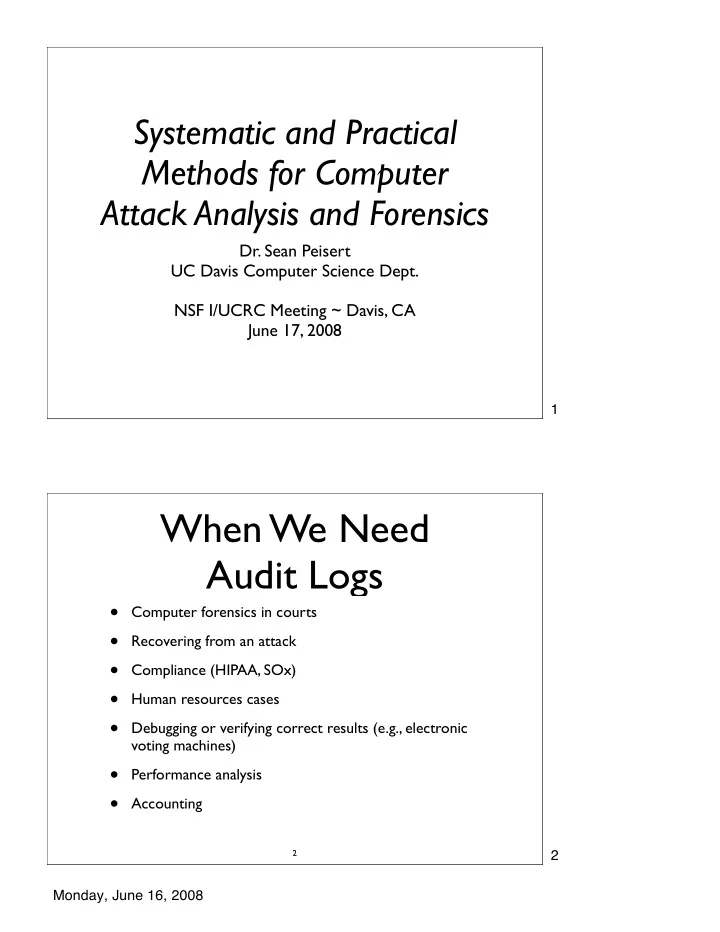

Systematic and Practical Methods for Computer Attack Analysis and Forensics Dr. Sean Peisert UC Davis Computer Science Dept. NSF I/UCRC Meeting ~ Davis, CA June 17, 2008 1 When We Need Audit Logs • Computer forensics in courts • Recovering from an attack • Compliance (HIPAA, SOx) • Human resources cases • Debugging or verifying correct results (e.g., electronic voting machines) • Performance analysis • Accounting 2 2 Monday, June 16, 2008
We’re terrible analyzing events on computers 3 Audit data is usually... • overwhelming • free-form • useless • misleading (easily altered) 4 4 Monday, June 16, 2008
We’re collecting too much bad information... 5 5 ...and using it in courts and elections. 6 6 Monday, June 16, 2008
We need to... • understand what the purpose of the analysis is • understand what data can answer that purpose, with X% accuracy, and under a set of Y assumptions • log the data • give tools and techniques to an analyst to analyze that data 7 7 How is computer forensics done now? • file & filesystem analysis (Coroner’s Toolkit, Sleuth Kit, EnCase, FTK) • syslog, tcpwrappers • process accounting logs • IDS logs • packet sniffing 8 8 Monday, June 16, 2008
What do we need? What are we missing? 9 9 A Systematic Approach is Better 10 10 Monday, June 16, 2008
Forensic Art & Science • But computer science can only answer part of it. • Forensic analysis is an art, but there are scientific components. What are they? • Determining what to log • Determining relevance of logged data • what is relevant? • what is not relevant? • under what circumstances something might be relevant? • Using the results to constrain and correlate data. • This can be measured, systematized and automated. 11 11 Measurement Example: Empirical Study of Firewall Rules • How are firewalls configured? • How should firewalls be configured? • What are the top, known vulnerabilities? • What are the top, known attacks? • What are we missing? Is that OK? 12 12 Monday, June 16, 2008
Laocoön: A Model of Forensic Logging • Attack graphs of goals. • Goals can be attacker goals or defender goals (i.e., “security policies”) • Pre-conditions & post-conditions of those goals. • Method of translating those conditions into logging requirements. • Logs are in a standardized and parseable format. • Logged data can be at arbitrary levels of granularity. 13 13 Attack Graphs intermediate steps (too many!) end goals of intruder start of attack • Intruder goals can be ... enumerated. ... ... ... • Vulnerabilities, attacks, ... ... and exploits cannot (or ... in many cases, we would a b c d patch them). • Defender goals can also be enumerated. They are called security polices. 14 14 Monday, June 16, 2008
Security Policies • Security policies can be reverse-engineered or enforced, automatically. • Policies can be binary (block access) or flexible (log something). • Policies can be static (always do this) or dynamic (uh oh—an intruder) 15 15 Applying Security Policies • Applying Laocoön to security policies guides where to place instrumentation and what to log. • The logged data needs to be correlated with a unique path identifier. • Branches of a graph unrelated to the attack can be automatically pruned. • Avoid recording data where events can be recreated because they are deterministic. 16 16 Monday, June 16, 2008
Pruning Paths start of attack intermediate steps end goals of intruder start of attack intermediate steps end goals of intruder A B C D A B C D 17 17 What are the assumptions for using current forensic tools? • Often that there’s only one person who had access to the machine. • Often that the owner of the machine was in complete control (as opposed to malware). • Probably a lot of other assumptions that we have no clue about. 18 18 Monday, June 16, 2008
Summary: we can do better • Forensics, attack analysis, logging, and auditing are broken. • We seek to work on real-world problems with real-world data to construct and implement useful, usable, real-world software solutions. 19 19 Proposed Project • Research practicality and tradeoffs in conditional access control (e.g., allow & log vs. block) • Implement conditional access control with several countermeasures, including logging. • For the logging portion, implement forensic logging of system & function calls, and analysis tools to correlate and prune data unrelated to the end goals that an analyst is concerned with. • If there is time, attempt to do this via virtual machine introspection. 20 20 Monday, June 16, 2008
Selected Recent Publications • S. Peisert, M. Bishop, and K, Marzullo, "Computer Forensics In Forensis, " Proc. of the 3rd Intl. IEEE Wkshp. on Systematic Approaches to Digital Forensic Engineering , May 2008. • S. Peisert, M. Bishop, S. Karin, and K. Marzullo, "Analysis of Computer Intrusions Using Sequences of Function Calls," IEEE Trans. on Dependable and Secure Computing (TDSC) , 4(2), Apr.-June 2007. • S. Peisert and M. Bishop, "How to Design Computer Security Experiments," Proc. of the 5th World Conf. on Information Security Education , June 2007. • S. P. Peisert, "A Model of Forensic Analysis Using Goal-Oriented Logging," Ph.D. Dissertation, UC San Diego, Mar. 2007. • S. Peisert, M. Bishop, S. Karin, and K. Marzullo, "Principles-Driven Forensic Analysis," Proc. of the New Security Paradigms Workshop (NSPW) , Sept. 2005. 21 21 Questions? • Dr. Sean Peisert • Email: peisert@cs.ucdavis.edu • More information and recent publications: • http://www.sdsc.edu/~peisert/ 22 22 Monday, June 16, 2008
Recommend
More recommend